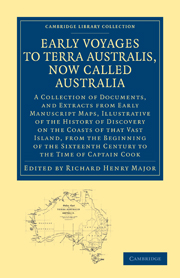 Early Voyages to Terra Australis, Now Called Australia
Early Voyages to Terra Australis, Now Called Australia Book contents
- Frontmatter
- Contents
- INSTRUCTIONS TO THE BINDER
- INTRODUCTION
- A MEMORIAL ADDRESSED TO HIS CATHOLIC MAJESTY PHILIP THE THIRD, KING OF SPAIN
- RELATION OF LUIS VAEZ DE TORRES
- EXTRACT FROM THE BOOK OF DISPATCHES FROM BATAVIA
- THE VOYAGE AND SHIPWRECK OF CAPTAIN FRANCIS PELSART
- VOYAGE OF GERRIT THOMASZ POOL TO THE SOUTH LAND
- ACCOUNT OF THE WRECK OF THE SHIP “DE VERGULDE DRAECK”
- DESCRIPTION OF THE WEST COAST OF THE SOUTH LAND
- EXTRACT TRANSLATED FROM BURGOMASTER WITSEN'S
- ACCOUNT OF THE OBSERVATIONS OF CAPTAIN WILLIAM DAMPIER
- EXTRACT FROM SLOAN MS., 3236
- SOME PARTICULARS RELATING TO THE VOYAGE OF WILLEM DE VLAMINGH
- EXTRACT FROM THE JOURNAL OF A VOYAGE MADE TO THE UNEXPLORED SOUTH LAND
- ACCOUNT OF THE OBSERVATIONS OF CAPTAIN WILLIAM DAMPIER
- A WRITTEN DETAIL OF THE DISCOVERIES AND NOTICEABLE OCCURRENCES
- THE HOUTMAN'S ABROLHOS
- INDEX
- Outline Chart of TERRA AUSTRALIS OF AUSTRALIA
- Plate section
THE VOYAGE AND SHIPWRECK OF CAPTAIN FRANCIS PELSART
Published online by Cambridge University Press: 05 February 2013
- Frontmatter
- Contents
- INSTRUCTIONS TO THE BINDER
- INTRODUCTION
- A MEMORIAL ADDRESSED TO HIS CATHOLIC MAJESTY PHILIP THE THIRD, KING OF SPAIN
- RELATION OF LUIS VAEZ DE TORRES
- EXTRACT FROM THE BOOK OF DISPATCHES FROM BATAVIA
- THE VOYAGE AND SHIPWRECK OF CAPTAIN FRANCIS PELSART
- VOYAGE OF GERRIT THOMASZ POOL TO THE SOUTH LAND
- ACCOUNT OF THE WRECK OF THE SHIP “DE VERGULDE DRAECK”
- DESCRIPTION OF THE WEST COAST OF THE SOUTH LAND
- EXTRACT TRANSLATED FROM BURGOMASTER WITSEN'S
- ACCOUNT OF THE OBSERVATIONS OF CAPTAIN WILLIAM DAMPIER
- EXTRACT FROM SLOAN MS., 3236
- SOME PARTICULARS RELATING TO THE VOYAGE OF WILLEM DE VLAMINGH
- EXTRACT FROM THE JOURNAL OF A VOYAGE MADE TO THE UNEXPLORED SOUTH LAND
- ACCOUNT OF THE OBSERVATIONS OF CAPTAIN WILLIAM DAMPIER
- A WRITTEN DETAIL OF THE DISCOVERIES AND NOTICEABLE OCCURRENCES
- THE HOUTMAN'S ABROLHOS
- INDEX
- Outline Chart of TERRA AUSTRALIS OF AUSTRALIA
- Plate section
Summary
The Directors of the East India Company, encouraged by the successful return of the five ships of General Carpenter, richly laden, caused eleven vessels to be equipped the very same year, 1628, for the same voyage: amongst which, there was one ship called the Batavia, commanded by Captain Francis Pelsart. He sailed from the Texel on the 28th of October 1628; and, as it would be tedious to the reader to give him a long account of a passage so well known as that to the Cape of Good Hope, I shall pass over in silence that portion of his journal, and content myself with observing, that on the 4th of June in the following year, 1629, this vessel, the Batavia, being separated from the fleet in a storm, was driven on some rocks which lie in the latitude of 28° south, and which are called by the Dutch the Abrolhos of Frederick Houtman. Captain Pelsart, who was sick in bed when this accident happened, perceived at once that his ship had struck. It was night, indeed; but the moon shone very brightly, and the weather was fair. He immediately ran upon deck, and found that all the sails were set; their course was north-east by north; and the sea appeared covered with a white froth as far as the eye could reach.
- Type
- Chapter
- Information
- Early Voyages to Terra Australis, Now Called AustraliaA Collection of Documents, and Extracts from Early Manuscript Maps, Illustrative of the History of Discovery on the Coasts of that Vast Island, from the Beginning of the Sixteenth Century, pp. 59 - 74Publisher: Cambridge University PressPrint publication year: 2010First published in: 1859


